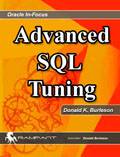 |
|
Oracle Database Tips by Donald Burleson |
B-Tree Index
By default, the Oracle creates a b_tree index. In
a b-tree, you walk the branches until you get to the node that has the
data you want to use. In the classic b-tree structure, there are
branches from the top that lead to leaf nodes that contain the data.
If I wanted to find the rowid for the number 28 in the b-tree defined
in Figure 5.3, I would start at the top or header block.
Is my number greater or less that 50? Well 28 is
less than 50, so I move to the branch marked 25. Is 28 greater or
less that 25? Since 28 is greater than 25, I move to the leaf node
marked 26-49. I scan this node for the rowid of the number 28. The
key to the b-tree in Figure 5.3 is that I can find any number from one
to 100 by reading no more than three nodes.
The Oracle database implements the b-tree index in
a little different manner. An Oracle b-tree starts with only two
nodes, one header and one leaf. The header contains a pointer to the
leaf block and the values stored in the leaf block. As the index
grows leaf bocks are added to the index (Figure 5.4).
To find a specific row, we look at the header to
find the range of values in each leaf and then go directly to the leaf
node that contains the value we are looking for. In the index in
Figure 5.4, any row can be found by reading two nodes. Since the
header contains only pointers to leaf blocks, a single header node can
support a very large number (hundreds) of leaf nodes.
If the header block fills, then a new header block
is established, and the former header node becomes a branch node.
This is called a three level b-tree (Figure 5.5).
In Figure 5.5, you can find any value in any leaf
node by reading no more than three blocks. I can also create a
multicolumn index, also called a concatenated or complex index.
SQL> create
index sales_keys
2 on sales (book_key, store_key, order_number);
Index
created.
Here, we created an index called sales_keys
on three columns of the sales
table. A multicolumn index can be used by the database but only from
the first or lead column. Our sales_keys index can be used in
the following query.
select
order_number,
quantity
from
sales
where
book_key = 'B103';
Note that the lead column of the index is the
book_key, so the database can use the index in the query above. I
can also use the sales_keys index in the queries below.
select
order_number,
quantity
from
sales
where
book_key = 'B103'
and
store_key = 'S105'
and
order_number = 'O168';
However, the database cannot use that index in the
following query because the WHERE clause does not contain the index
lead column.
select
order_number,
quantity
from
sales
where
store_key = 'S105'
and
order_number = 'O168';
Also, note that in the query below, the database
can answer the query from the index and so will not access the table
at all.
select
order_number
from
sales
where
store_key = 'S105'
and
book_key = 'B108';
As you can see, b-tree indexes are very powerful.
You must remember that a multicolumn index cannot skip over columns,
so the lead index column must be in the WHERE clause filters. Oracle
has used b-tree indexes for many years, and they are appropriate from
most of your indexing needs. However, the Oracle database provides
specialized indexes that can provide additional capabilities; the
bit-mapped index and the function-based index.
 |
|
Get the Complete
Oracle SQL Tuning Information
The landmark book
"Advanced Oracle
SQL Tuning The Definitive Reference" is
filled with valuable information on Oracle SQL Tuning.
This book includes scripts and tools to hypercharge Oracle 11g
performance and you can
buy it
for 30% off directly from the publisher.
|
|
